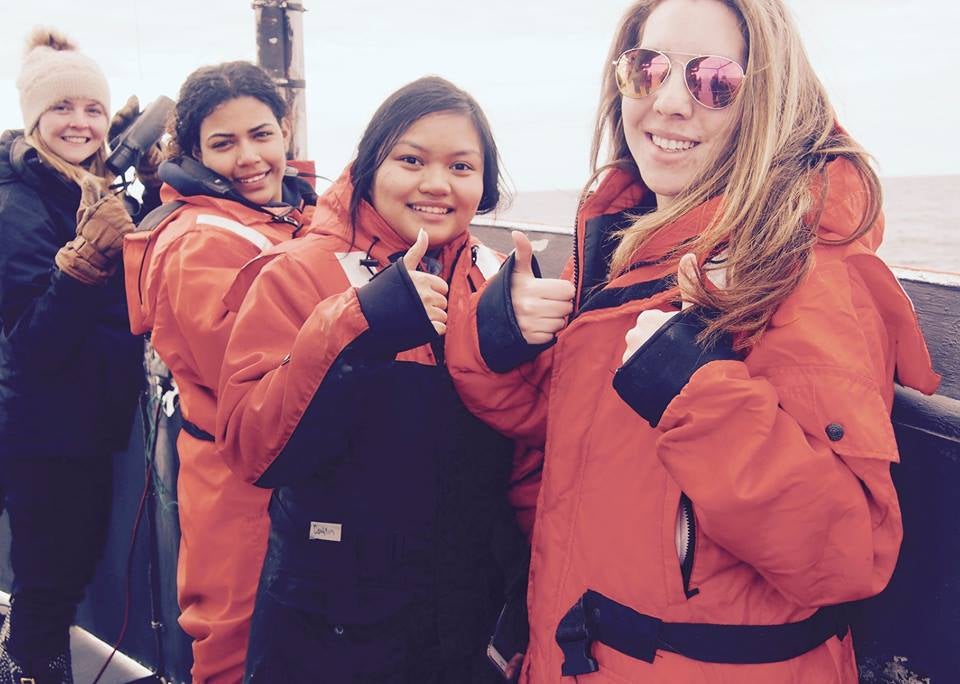Imagine looking to sign up for classes and seeing an undergraduate course that was described as “only available to honors students, taught through the Graduate School of Oceanography, must be available to be off campus April 3-8 and to be videotaped doing research”. Would that pique your interest? It did for 8 University of Rhode Island undergraduates.
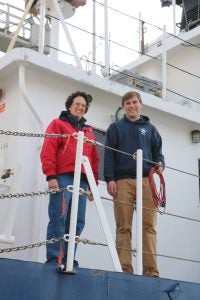
The course, called “CSI: Oceans” was taught by two members of the Graduate School of Oceanography (GSO) community, Karen Wishner and Christopher Orphanides (see photo left). The Chief Scientist, Chris Orphanides, is not your typical teacher and Chief Scientist since he is also a graduate student at the Graduate School of Oceanography and a researcher at the Narragansett office of the National Ocean and Atmospheric Administration (NOAA). And the other teacher, professor Dr. Karen Wishner, is more typically found on research cruises far offshore, looking at deep sea areas of waters with low oxygen. The eight undergraduate honors students who signed up for the course had a variety of majors, not necessarily related to the ocean: two marine biology majors, Erin Chille and Lizzie Ilagan; two ocean engineering majors, Ethan Koproski and Gwen Fall; a marketing/communications major, Gal Jennings; a civil engineering major, Bradley Bzdyra; a psychology/sociology major, Genesis Jimenez; and a political science/communication science major, Mike Ricker. The course included a 6-day research cruise on the R/V Endeavor that went from Narragansett to waters near Block Island and Nantucket and back (see photo below). And one more thing atypical about this expedition – the whole cruise was broadcast live through the Inner Space Center (ISC) via telepresence.
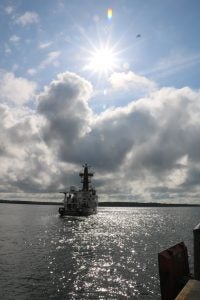
The course is a product of the “Rhode Island Endeavor Program” (RIEP) in which state funds are used to cover up to 20 days at sea for RI researchers, grad students, undergrads, or K-12 teachers on the R/V Endeavor for scientific research and educational training purposes. The cruises are usually short, about 6 days, and are often used for testing out a new idea or new equipment. Proposals are solicited annually, submitted to a competitive program, and reviewed by a committee and the GSO Dean. For more on this program, go to https://web.uri.edu/gso/rhode-island-endeavor-program-program-overview/
For this course and cruise, Chris Orphanides and Karen Wishner were blending their extensive experience with marine mammals (Chris) and zooplankton (microscopic animals, including copepods and krill, which are food for many whale species, see photo below) (Karen) to investigate where the endangered North Atlantic right whale (Eubalaena glacialis) could be located based on where their food sources were found. Before going out on the water, there were weeks of classes covering everything from whales, their food, to how to interact with the camera (see photo below). The course and cruise were focused not just on the whales, but on “the linkages between tropic levels” said Chris. These whales are baleen whales, meaning instead of teeth they have a dense fringe of keratin (the same material that makes up our fingernails and hair). They use this baleen to strain small fish, krill, zooplankton or other prey items from seawater and swallow them. This is timely research because the North Atlantic right whale has been on the Endangered Species List since 1970 and has a known present population of about 450 animals. About 18 were known to die last year, and no new calves have been sighted this spring. Chris noted that “historically, whaling was the main cause of death, now it is attributed to entanglements in fishing lines, ship strikes, and changes in food sources abundance. These changes in food sources are often the result of changes in large scale oceanic features, such as the North Atlantic Oscillation” and perhaps due to shifts in climate.
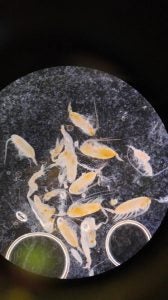
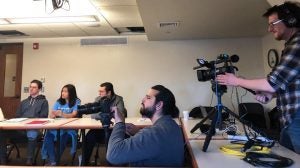
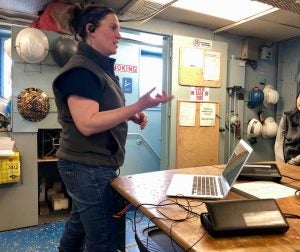
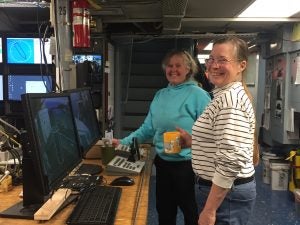
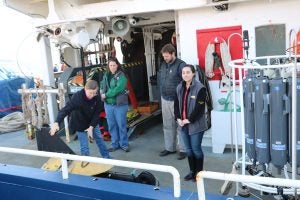
On board the cruise to offer help and guidance to the students was Marine Biologist Holly Morin, who is an Educator at URI-GSO’s Inner Space Center (see photo left). From NOAA’s Northeast Fisheries Science Center in Woods Hole, MA came Betsy Broughton who ran the video plankton recorder (VPR) and also provided guidance to students on plankton biology and identification. Also from NOAA, Chris Tremblay added his expertise on whales and marine mammal surveys. The entire crew of the R/V Endeavor played key roles in the functioning of the ship and the performance of the science, skills particularly crucial in the heavy seas and strong winds the ship encountered. Lynn Butler, marine technician of the R/V Endeavor, was especially helpful to the students, with deploying, running, and retrieving equipment. (See photos above).
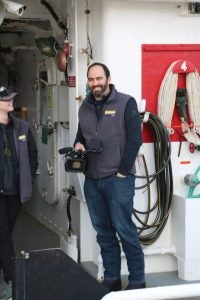
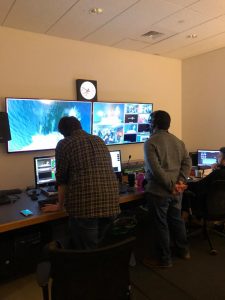
Because the cruise was broadcast, as Karen pointed out: “your goal is to explain what we see to the public”. This also provided the opportunity to, as Holly said, “let the audience live vicariously through you!”. Holly hosted the broadcasts that over the cruise included all of the students. Video and Production Engineer Lew Abramson (see left photo), working for the ISC, taped and broadcast the shows from the ship and also guided the students on how to work in front of and behind the cameras. Back on shore at the ISC, Alex DiCicco and Kyle Sidlik reviewed footage (see right photo) and sent out links, while Andrea Gingras, Manager for ISC Ocean Science Education, and ISC Director Dwight Coleman kept everything coordinated. Thirty-five different K-12 school groups, which included almost 950 students, registered for the cruise broadcasts and were able to connect to the ship in real time, learn about cruise activities, and student experiences, as well as ask questions directly to those on board the ship. The cruise also had a large social media presence, with numerous post through the ISC’s Twitter, Facebook, and Instagram pages. Three Facebook live broadcasts also took place.
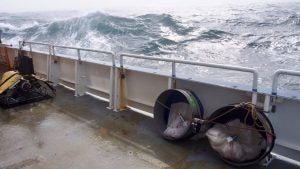
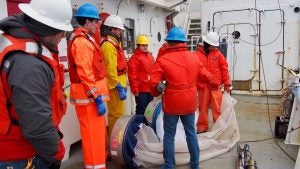
So what did the student-researchers do? They were trying to characterize the waters to see if, based on oceanographic descriptions, the waters were likely to contain the zooplankton and krill that whales feed on. The weather was cold, windy, and sometimes rainy, and the seas were rough (see photo above left) so not all of the equipment was able to be deployed as often as planned. Using a CTD instrument, they took readings in the water of conductivity (a way of measuring salinity), and temperature that changed with depth. They deployed bongo nets (double nets that looked like bongo drums) (see photo above right) and towed them in the water to capture zooplankton that they could look at under the microscope. They towed the video plankton recorder that took rapid strobe light photos of the plankton in the water. And always, someone was on the flying bridge using the “big eyes” binoculars to scan the waters for whales (see photo below).
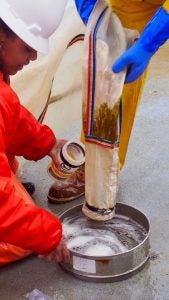
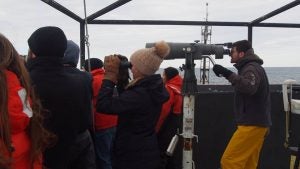
What did the student-researchers find out about this ocean environment? They all found out that they could survive seasickness and continue working – yeah! The water was cold, around 5oC (or 41oF). There were lots of phytoplankton, as could be seen by the “green goo” clogging the nets (see right photo). This year there has been an unusually long and intense winter-spring bloom (population explosion) of phytoplankton in the waters near Rhode Island and the cruise samples were probably a reflection of that. Zooplankton were sparse, and there was only a few of the right whale’s favorite food, the copepod Calanus finmarchicus. It was rough seas most days, so hard to see anything on the surface of the water. So it’s not surprising that despite day after day of watching, no right whales and no marine mammals of any kind were seen. But then, on the last afternoon, the cruise participants finally saw two right whales! (see 2 photos below)
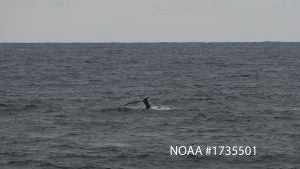
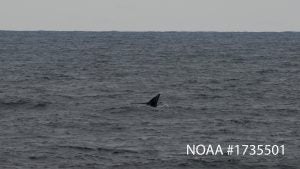
And what else did the student-researchers find out about? Erin: that she was “living her dream of being a marine biologist on a ship”; Lizzie: she was “constantly hearing that the ocean is mostly unexplored” but “there is enough research going on that individual whales can be identified”; Ethan: that research cruises “are so important for getting out into the field itself and looking at what is really going on outside”; Gwen: she “really liked the outreach and communicating our findings to the schools and seeing that in action”; Gal: that “we could work together towards one goal, as one team, getting all this information out”; Bradley: that “he could get over seasickness …. and move on and become part of the crew for the rest of the trip”; Genesis: she “loved being free on the ocean for almost a whole week without having to worry about classes or work”; and Mike “the best part was how close we all became…from not really knowing these seven other people to becoming close friends”.
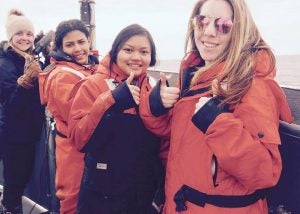
As part of their final report for the class, one of the students, Gal Jennings, put together a video that is a great summary of the cruise, be sure it check it out: https://www.youtube.com/watch?v=ydYbSHwUpus . The students started out in the class being excited about the prospect of seeing whales, but in the end, the class and cruise was about so much more than that. As Gal wrote at the end of her video “thank you for the experience of a lifetime”. Sounds like it was not your typical undergraduate class.
Volume 1, Number 4
May 16, 2018
This (B)log was based on interviews with Chief Scientist Christopher Orphanides, Dr. Karen Wishner, remarks made by the students, staff, and teachers during classes before and after their cruise, and videotaped cruise remarks that can be found at the links below.
To check out more about the cruise, see the Inner Space Center Website: http://innerspacecenter.org/live-video/endeavor-live/
To see tweets from the cruise: #EndeavorLive
To look at Facebook posts: https://www.facebook.com/innerspacecenter/
If you are a URI student interested in a research cruise, find out more about next year’s Honors Class Endeavor cruise, contact Andrea Gingras at agingras@uri.edu
If you are URI faculty and are interested in submitting a proposal for a 2019 RI Endeavor Program research cruise, they are due June 28 via email. Contact Amy Smith in the GSO Dean’s Office at ahsmith@uri.edu
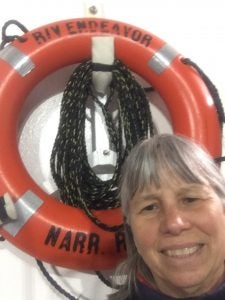 This blog post was written by Veronica M. Berounsky, GSO Science Correspondent and Coastal Ecologist. She first arrived at GSO in March of 1979 as a research lab tech. In 1990 she obtained her Ph.D., working on nitrification in Narragansett Bay with the late Scott W. Nixon. She continues to be fascinated by the ecology of coastal ecosystems every day. With this blog she hopes to increase your understanding of the activities and people of GSO and the Narragansett Bay Campus. Please email any comments to her at vmberounsky@uri.edu. Click on the title at the end to see the previous post.
This blog post was written by Veronica M. Berounsky, GSO Science Correspondent and Coastal Ecologist. She first arrived at GSO in March of 1979 as a research lab tech. In 1990 she obtained her Ph.D., working on nitrification in Narragansett Bay with the late Scott W. Nixon. She continues to be fascinated by the ecology of coastal ecosystems every day. With this blog she hopes to increase your understanding of the activities and people of GSO and the Narragansett Bay Campus. Please email any comments to her at vmberounsky@uri.edu. Click on the title at the end to see the previous post.
Or click here to see all previous Bay Campus (B)logs.

